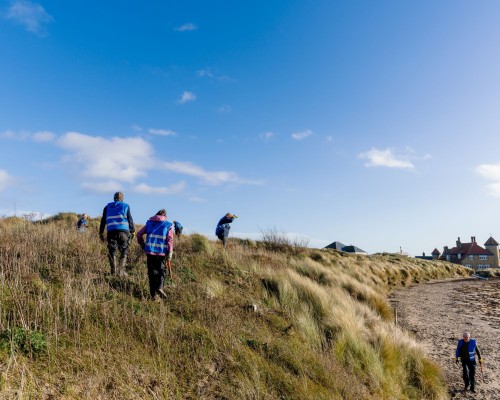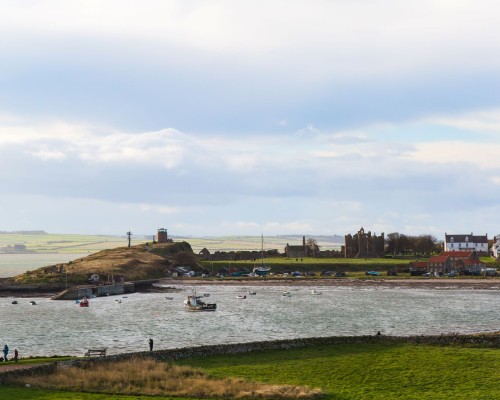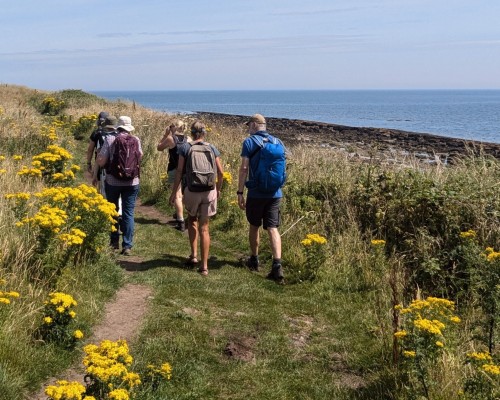

Coquet Island is an RSPB reserve about a mile offshore from the port of Amble, and just outside the National Landscape. It is home to a huge number of nesting seabirds including the very rare Roseate Tern (c.125 pairs in 2025). Coquet Island holds more than 95% of the UK population of this beautiful seabird and is the best place to see them in the UK.
Several thousand nesting Sandwich, Arctic and Common Terns accompany the Roseates in May, June and July, and thousands of Puffins occupy the main part of the island.
Nesting birds are everywhere on Coquet and for this reason, visitors are not allowed to land on the Island. The birds can be viewed incredibly well from boats that sail around the island. ‘Puffin Cruise’ boats go out to Coquet Island from Amble Harbour. They sail around the island before anchoring-off, giving passengers fantastic views of the nesting roseate terns. From the boat you can see the friendly Grey Seals swimming and playing, of which there are hundreds each year.
In the middle of Beadnell Bay, where the Long Nanny Burn runs out onto the beach, there is a colony of nesting terns during the summer.
Approximately 5,000 pairs of nesting Arctic Terns and a small number of pairs (usually between 20-35) of the very rare Little Tern make it their home each summer, as do the National Trust Rangers who look after them.
To visit the Long Nanny tern colony you must walk the mile or so from either High Newton-by-the-Sea or Beadnell, and both are served by regular buses. Please follow signs as you approach the site to avoid disturbing the birds, if you have a dog, keep it on a lead.
Do go to the Rangers’ hut where they will be happy to show you the birds.

Scattered a couple of miles offshore from Seahouses, the Farne Islands are a seabird paradise. There are between 15 and 20 islands dependent on the tide and during the summer they are home to over 150,000 pairs of seabirds of over 23 species.
The islands are an amazing place to see seabirds at close quarters, attracting photographers from around the world. As well as about 37,000 pairs of Puffin, the islands host large colonies of Shag, Kittiwake, Guilliemots, Black-headed gulls and three species of terns.
The islands are also home to an important Grey Seal colony. In the autumn, over 1000 seal pups are born on the islands.
Dolphins, porpoise and even whales are increasingly seen off the Northumberland Coast and can be spotted from the shore or while on a boat trip, typically from Seahouses harbour or Amble.
The Harkess Rocks in Bamburgh are more commonly known as Stag Rock because of the white stag that has been painted on them for many years. The rocks are whinstone and jut out into the North Sea. Despite the popularity of the area, this is one of the best places to see rocky shore waders such as Purple Sandpiper, Knot and Turnstone.
Purple Sandpipers are known locally as ‘penny men’ and sometimes over 100 birds can gather here. You can also see rocky shore species at Seahouses harbour and Low Newton-by-the-Sea.

The Northumberland Coast National Landscape is a birdwatching paradise, throughout the seasons.
The Northumberland Coast has several important seabird colonies where thousands of seabirds come ashore during the spring and summer to raise their young.
Breeding season begins in the spring, when nest protection preparation is underway by Space for Shorebirds, Natural England and National Trust rangers. Key species found nesting on the Northumberland Coast include Ringed Plover and Oystercatcher which favour sandy and shingle beaches, making them vulnerable to disturbance from people and dogs. Keep an eye out for fenced off areas in the National Landscape, with Space for Shorebirds, National Trust, Natural England and our own Conservation Team volunteers watching over precious nesting pairs and chicks at beaches including Embleton Bay, Buston Links and Beadnell.
The Long Nanny shorebird site between Low Newton and Beadnell Bay is an internally internationally important breeding site for several species, including Ringed Plover, Arctic Tern and Little Tern. A section of coastline between Beadnell and High Newton is roped off every year ahead of breeding season to protect the nesting grounds of these birds. Signage here explains why these areas are important, and why they are fenced off.
Activity at the seabird colonies on the Farne Islands and Coquet Island peaks in June and July. During this time, you can spot Puffin, Shag, Guillemot, Razorbill, various gulls Black-headed Gulls and three species of terns.
From August into autumn, you may see species passing through on their way from northern breeding areas to their winter quarters while birds that come here for the winter also begin to arrive.
Autumn is an exciting time for birdwatchers as birds that do not normally spend much time here pass through as they migrate south for winter. For many species, their normal route will take them through Northumberland, for others they will have been blown off-course and arrive here by accident.
Autumn migration lasts from the end of July through to early November. Early in the autumn, wading birds pass through on their way from the Arctic to Africa. Places like Newton-by-the-Sea, the Coquet Estuary and Lindisfarne are good places to look.
Later in the season, large arrivals of birds from the north and east are a real spectacle. Huge numbers of wintering thrushes such as Redwing and Fieldfare can be seen arriving, with them Long-eared and Short-eared Owls can be seen flying in from the sea. Other ‘northern breeders’ and birds from as far as eastern Russia can arrive through September and October.
The best places to look for migrant birds in suitable conditions are:
• Holy Island – the island acts as a magnet for birds arriving from the east. Usually geese, ducks and wading birds.
• Craster – check the Arnold Memorial Reserve and surrounding areas for small birds such as warblers and thrushes
• Warkworth – the picnic site car park and surrounding bushes can be good for small birds as can a walk through the dunes.

In late autumn, tens of thousands of ducks, geese and wading birds arrive on the Northumberland coast to spend the winter. Many of these birds will have come from the Arctic Circle.
Inland from the coastal margins, the fields, farms and woodlands of the Northumberland Coast are home to a wide range of birds throughout the year.
A walk along any of the public rights of way is the best way to see farmland species. Three good areas to see farmland birds are:
• From the Northumberland Coast Path between Seahouses and Bamburgh. Walk one way and catch the bus back.
• The area around Newton-by-the-Sea.
• From the Northumberland Coast Path between Warkworth and Alnmouth and Alnmouth to Craster.
There isn’t much mature woodland on the Northumberland coast so woodland birds can be difficult to see. Probably the best place to see woodland species is around Howick Hall Gardens.

The dune systems, meadows and grasslands found on whinstone outcrops on the Northumberland Coast are home to an amazing array of specialised and increasingly rare plant life.
Dune systems
Sand dunes are dynamic features of the coast and are mostly calcareous alkaline in nature because of the high shell content of the sand. Sand dune plants need to be tolerant of hostile conditions and many species are only found in this habitat.
Extensive, flower-rich dune systems can be found in the Lindisfarne area from Cocklawburn through Cheswick, Goswick and Holy Island. Species-rich dunes can also be found at Bamburgh, Embleton, Buston Links and Warkworth. Many of these sites are designated as Sites of Special Scientific Interest (SSSIs) and Special Areas of Conservation for their habitat and plant species.
Meadows
Traditional meadows are less common than they used to be, with grass cut for silage rather than hay nowadays. Some grasslands are managed specifically for wildflowers using a hay meadow management regime. The National Trust looks after a large area of meadow at Newton Point which is worth visiting in late spring and early summer for its profusion of wildfowers such as Ox-eye daisy, Yellow Rattle, Cat’s-ear and Red Clover.
Saltmarshes
Where rivers and streams meet the sea, slowing waters deposit sediment and saltmarshes can form. Moving away from the sea, the amount of time the saltmarsh is covered in salty water decreases and this variation creates zones where different species can survive depending on how tolerant they are to emersion.
In summertime, despite being regularly covered by the sea, saltmarshes can be a carpet of pink in the zone where Thrift flourishes. Other typical species, often with interesting names include Glasswort, Sea Sandwort, Sea Arrowgrass, Sea Blite, Sea Purslane and Oraches. Saltmarshes are rare and protected and mostly privately owned so please appreciate them from the edge.
Saltmarshes can be found at Warkworth, Alnmouth and around Lindisfarne National Nature Reserve.
Whin grassland
The term whin grassland is a collective one, describing a set of plant communities associated with the geology of the Whin Sill. The Great Whin Sill is a tabular layer of the igneous rock dolerite that occurs in northern England and forms cliffs and outcrops on the coast between Howick and Holy Island.
Whin grassland is therefore only found at a small number of places, where thin, nutrient-poor soils overlie outcrops of whinstone. Incorporate the harsh maritime conditions at the coast and it is easy to see why the plant communities of the whin sill here are so specialised.
Places to look for whin grassland
The Heugh on Holy Island – a narrow ridge of whin outcrop, south of Lindisfarne Priory.
Craster to Dunstanburgh Castle and south of Craster to Cullernose Point– A walk along the Northumberland Coast Path in late May is a very good time to see whin flora.

There are interesting bugs, beetles and flies that only live by the seaside. The typically tall, single-ridged dunes here are special, and areas of bare sand among them are also important for wildlife. A mosaic of grasses and plants of different heights mixed with areas of bare sand – usually achieved by grazing cattle – is ideal for providing a home to a wide range of plants and animals, especially insects.
Here are some insects to look out for in the Northumberland Coast National Landscape:
Common Blue Butterfly – the bright blue males are easily spotted.
The Coastal Stiletto Fly is a bare-sand specialist, and it is usually only seen on warm, sunny days, basking on the sand.
Black Marram Weevil is another lover of the open sandy areas.
Dark Green Fritillary Butterfly – a large orange beautiful butterfly that feeds lays it eggs on common dog-violet (the dark green in the name refers to dark green spots on the underside of the wing).
Burnet Moths – black and red spotted day-flying moths, often found on thistles, knapweed and scabious yellow ragwort flower.
Cinnabar Moth Caterpillars – yellow and black striped caterpillars that are a good source of food for young cuckoos, often found on ragwort flowers .
Dune Robberfly – a large fearsome looking fly an inch long can be found throughout the summer on warm sandy patches and footpaths in the outer dunes

The Conservation Team is a volunteer initiative carrying out vital tasks.
Find out more
Discover the traditional villages and lively harbours in the Northumberland Coast National Landscape.
Find out more
The Northumberland Coast Path is a 60-mile linear route along the coastline from Cresswell in the south to Berwick-upon-Tweed in the north, which can be separated into six stages.
Find out more